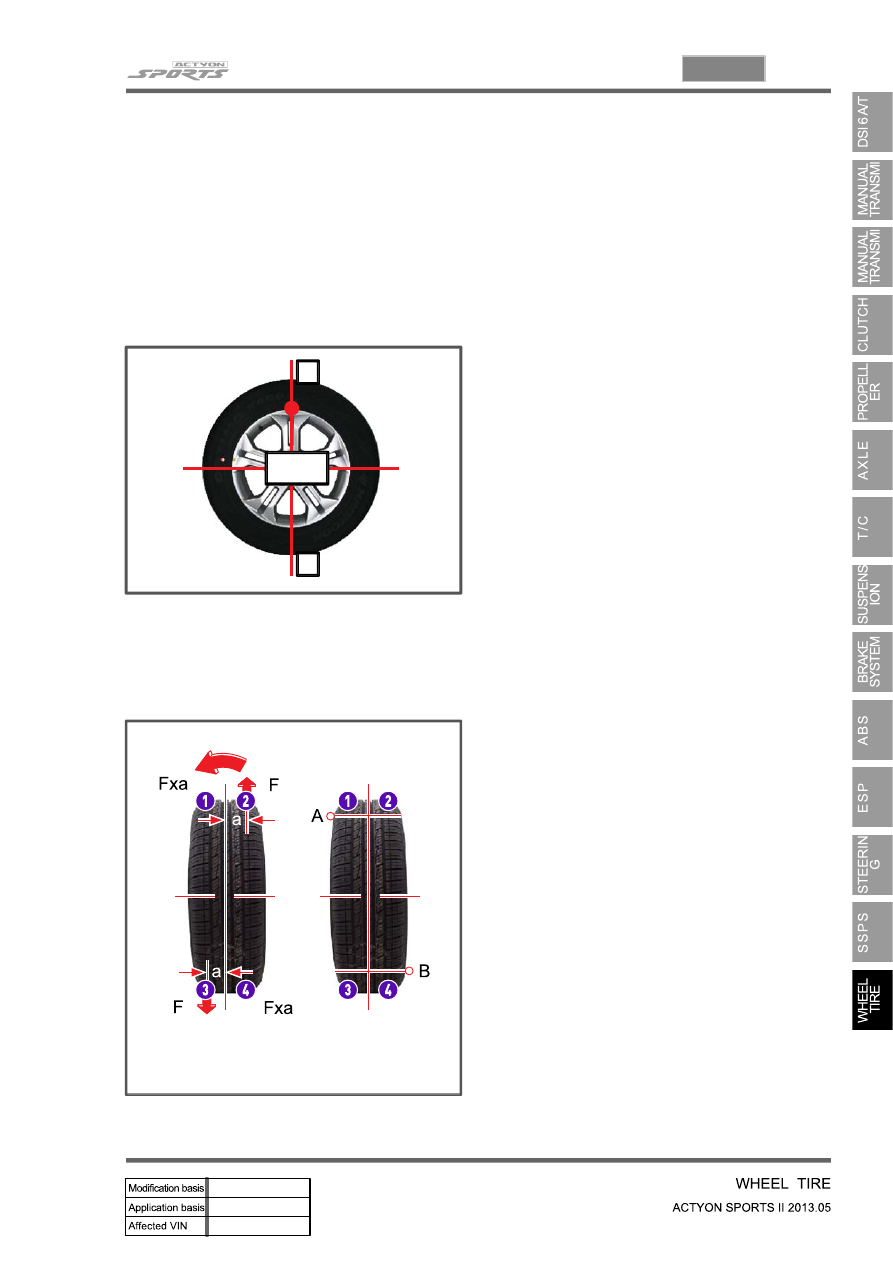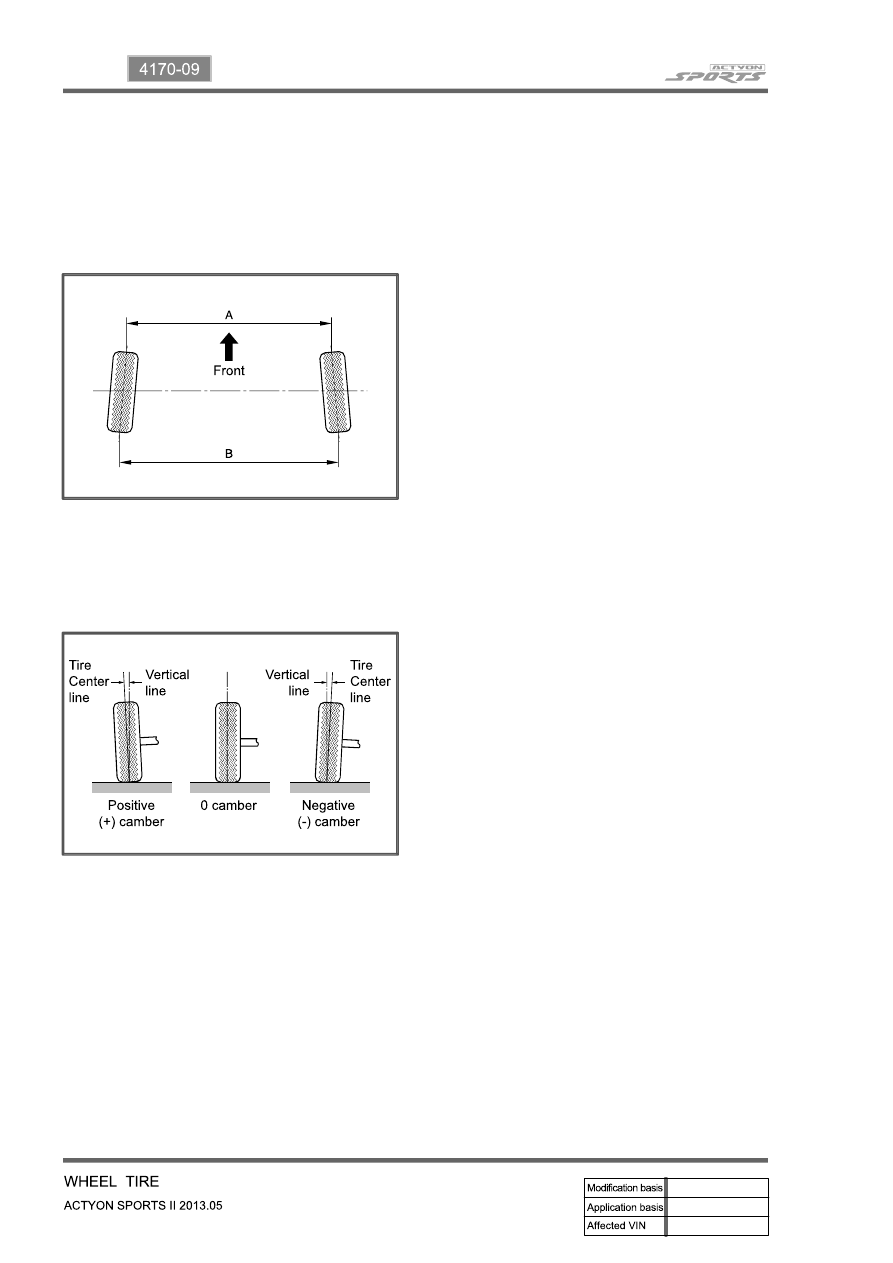SsangYong Actyon Sports II. Manual — part 170

14-16
When the vehicle is driven on a road surface covered with water at high speed, tires do not contact with
the road surface but rotate floating on a thin film of water.
It causes brake failure, lower traction force and losing the steering performance.
To prevent this, increase the tire inflation pressure, use tires with leaf shape tread which is not worn.
However, it is a best measure to drive slowly.
Hydro Planing
▶
Vehicle speed ≤ 60 km/h
No Hydro planning
Vehicle speed = 80 km/h
Partial Hydro planning
Vehicle speed ≥ 100 km/h
Full Hydro planing

14-17
4170-09
If weight is not equally distributed around the wheel, unbalance centrifugal force by the wheel rotation
produces vibration. As the centrifugal force is produced proportional to the square of the rotating speed,
the wheel weight should be balanced even at high speed. There are two types of the tire and wheel
balancing: static and dynamic. Abnormal vibration may also occur due to unbalanced rigidity or size of
tires.
Static Balance
▶
When the free rotation of the wheel is allowed,
the heavier part is stopped on the bottom if the
wheel weight is unbalanced and this is called
"Static Unbalance". Also, the state at which tire's
stop position is not same is called "Static
Balance" when the wheel is rotated again. If the
part A is heavier as shown in the figure 1, add
the balance weight of a weight corresponding to
unbalanced weight from B to A to maintain the
static balance. If the static balance is not
maintained, tramping, up and down vibration of
the wheels, occurs.
Dynamic Balance
▶
The static unbalance of the wheel creates the
vibration in the vertical direction, but the dynamic
unbalance creates the vibration in the lateral
direction. As shown in the figure 2 (a), if two
parts, (2) and (3), are heavier when the wheels
are under the static balance condition, dynamic
unbalance is created, resulting in shimmy, left
and right vibration of the wheels, and the torque
Fxa is applied in the axial direction. To correct
the dynamic unbalance, add the balance weight
of a same weight for two points of the
circumference of the rim, A and B, as shown in
the figure 2 (b), and apply the torque in the
opposite direction to the torque Fxa to offset in
order to ensure smooth rotation of the wheel.
Center
A
B
(a) (b)
[Figure 1]
[Figure 2]
3. WHEEL BALANCE

14-18
4. WHEEL ALIGNMENT
▶Toe-in
▶Camber
In automotive engineering, toe, also known as
tracking, is the symmetric angle that each wheel
makes with the longitudinal axis of the vehicle, as a
function of static geometry, and kinematic and
compliant effects. This can be contrasted with
steer, which is the anti-symmetric angle, i.e. both
wheels point to the left or right, in parallel (roughly).
Positive toe, or toe in, is the front of the wheel
pointing in towards the center line of the vehicle.
Negative toe, or toe out, is the front of the wheel
pointing away from the center line of the vehicle.
Toe can be measured in linear units, at the front of
the tire, or as an angular deflection.
Camber is the angle made by the wheels of a
vehicle; specifically, it is the angle between the
vertical axis of the wheels used for steering and
the vertical axis of the vehicle when viewed from
the front or rear. It is used in the design of steering
and suspension. If the top of the wheel is farther
out than the bottom (that is, away from the axle), it
is called positive camber; if the bottom of the
wheel is farther out than the top, it is called
negative camber.
Wheel alignment consists of adjusting the angles of the wheels so that they are parallel to each other
and perpendicular to the ground, thus maximizing tire life and ensures straight and true tracking along a
straight and level road.
Camber angle alters the handling qualities of a particular suspension design; in particular, negative
camber improves grip when cornering. This is because it places the tire at a better angle to the road,
transmitting the forces through the vertical plane of the tire rather than through a shear force across it.
Another reason for negative camber is that a rubber tire tends to roll on itself while cornering. Negative
camber can also be caused by excessive weight on the front wheels. This is commonly seen on
modified cars with larger engines than standard; the weight of the modified engine can make the wheels
negatively camber. The inside edge of the contact patch would begin to lift off of the ground if the tire had
zero camber, reducing the area of the contact patch. This effect is compensated for by applying negative
camber, maximizing the contact patch area. Note that this is only true for the outside tire during the turn;
the inside tire would benefit most from positive camber.

14-19
4170-09
▶Caster
Caster is the angle to which the steering pivot
axis is tilted forward or rearward from vertical, as
viewed from the side. If the pivot axis is tilted
backward (that is, the top pivot is positioned
farther rearward than the bottom pivot), then the
caster is positive; if it's tilted forward, then the
caster is negative.
Positive caster tends to straighten the wheel
when the vehicle is traveling forward, and thus is
used to enhance straight-line stability. The
mechanism that causes this tendency is clearly
illustrated by the castering front wheels of a
vehicle. The steering axis of a vehicle wheel is
set forward of where the wheel contacts the
ground. As the vehicle is driving forward, the
steering axis pulls the wheel along, and since the
wheel drags along the ground, it falls directly in
line behind the steering axis. The force that
causes the wheel to follow the steering axis is
proportional to the distance between the steering
axis and the wheel-to-ground contact patch-the
greater the distance, the greater the force. This
distance is referred to as "trail."

Нет комментариевНе стесняйтесь поделиться с нами вашим ценным мнением.
Текст